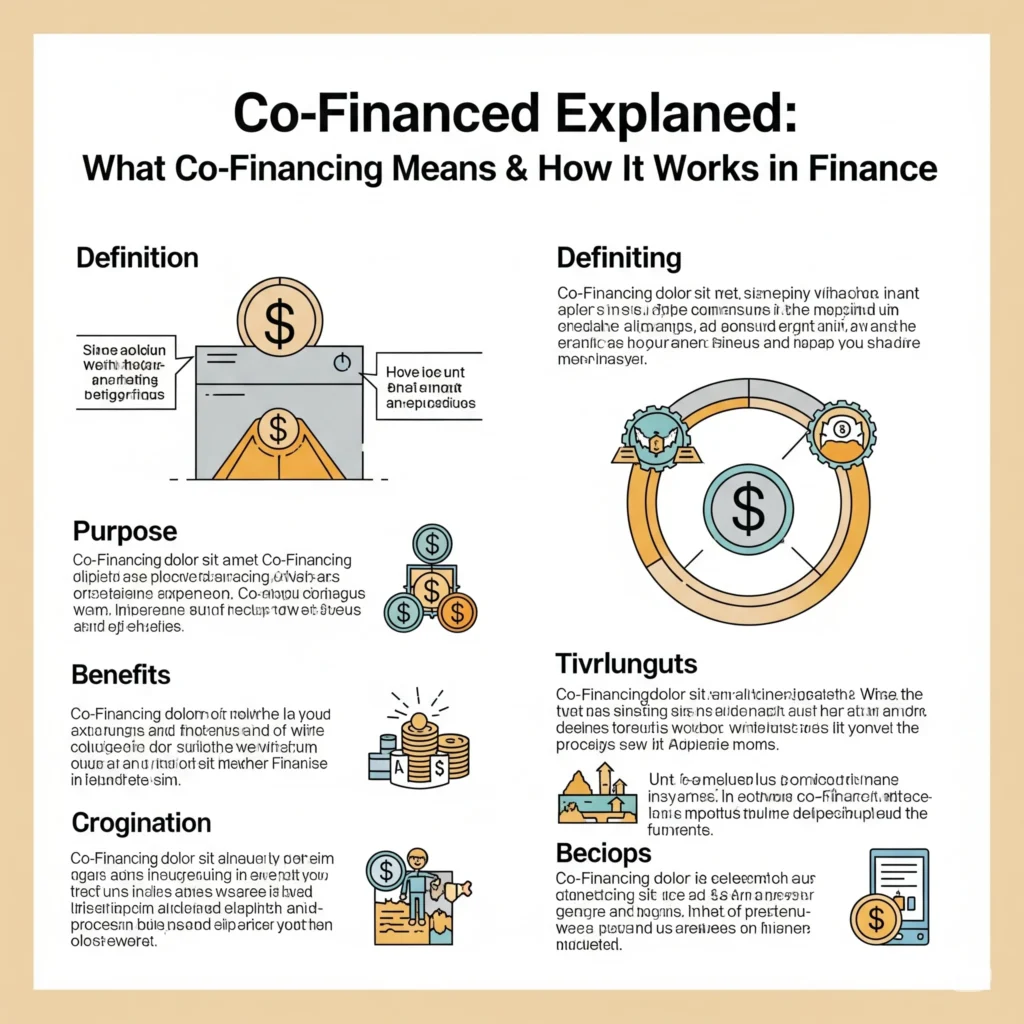In the world of finance, the term co‑financed often appears when multiple parties come together to fund a single venture. Whether you’re exploring a business loan, government-funded project, or joint venture, understanding co‑financed arrangements can be a game-changer. This informational guide will dive into what co‑financed means, how co‑financing works, the benefits and risks, and what to consider before participating in such financial structures.
What Does “Co‑Financed” Mean?
To co‑finance (verb) means to jointly fund something alongside one or more other entities—be it banks, organizations, governments, or partners.
In legal terms, co‑financing refers to funds provided by separate creditors under loan agreements officially specifying each party’s contribution.
Simplified Definition
“To join one or more others in providing money or funds for something.”
Common Co‑Financing Structures
1. Syndicated Bank Loans
Often large-scale loans are co‑financed by a group of banks. Each lender provides a portion of the loan under a shared set of documents, but interest rates or terms may vary among them.
2. Development Project Co‑Financing
Multilateral development banks frequently co‑finance public infrastructure. Funds are pooled from various international agencies or governments under joint governance.
3. Grant or Subsidy-Based Co‑Financing
Governments may co‑finance private projects through grants—also known as pure co‑financing—supporting part of the capital expenditure without expecting repayment.
4. R&D and Academic Projects
Research funding agencies may require recipients to co‑finance projects by contributing additional money or staff time as part of eligibility.
Why Do Entities Choose Co‑Financing?
✅ Key Advantages
- Resource pooling: Access larger funding amounts than one lender could finance alone.
- Risk distribution: Each party shares only a portion of the total risk.
- Strategic alignment: Partners work together toward shared project goals.
- Efficiency: Streamlined processes reduce duplicate paperwork and transaction costs.
⚠️ Potential Drawbacks
- Complex coordination: Aligning schedules, terms, and legal frameworks across financiers adds complexity.
- Conditionality: Co‑financing may come with specific requirements—like in‑kind contributions or milestone achievements.
- Administrative overhead: Monitoring commitments and compliance across funders can be burdensome.
Where Co‑Financing Is Commonly Used
⚙️ Corporate & Project Financing
Large infrastructure, energy, or industrial projects use syndicated loans, with co‑financiers providing varying portions—e.g., Bank A provides 40%, Bank B 30%, and Bank C another 30%.
🏦 Public Policy & Development
Co‑financing is common in global development projects, where funds from multiple international organizations are coordinated to reduce duplication and increase impact.
🎓 Academic & R&D Grants
Recipients often must co‑finance by dedicating staff time or complementary project funding, sometimes up to 150% of the grant value.
🏗 Public-Private Partnerships (PPPs)
Government bodies and private firms may co‑finance with direct grants or favorable loans to bridge viability gaps, often covering 30–40% of project capital expenditures.
How Co‑Financing Works: Step by Step
- Define Funding Needs: Estimate total capital required.
- Identify Co‑Financers: Potential lenders might include banks, multilateral institutions, or governments.
- Agree on Structure: Determine loan/budget amounts, rate terms, and legal coordination.
- Draw Agreements: Legal documents define obligations, repayment schedules, and conditions.
- Disburse Funds: Funds are provided according to milestones or needs.
- Monitor & Report: Each financier receives accountability and updates on progress and compliance.
Best Practices for Co‑Financed Deals
- Clarify Roles Early: Who does what, and when are funds disbursed?
- Standardize Documentation: A unified agreement—especially for syndicated loans—minimizes risk.
- Track All Contributions: Include in‑kind and financial inputs in total funding analysis.
- Set Clear Conditions: Milestones, deliverables, and accountability metrics should be well-defined.
- Use Lead Financier Model: One party often takes the lead in coordinating and monitoring.
- Conduct Periodic Auditing: Regular reviews ensure compliance with all financier requirements.
Frequently Asked Questions
Does “co‑financed” mean shared debts or grants?
It can refer to both—debt (loans) or non‑repayable funding (grants)—depending on the structure.
Can co‑financing include non-cash contributions?
Absolutely. Many programs accept in‑kind inputs like staff time, equipment, or service commitments.
Is co‑financing the same worldwide?
While the principle is universal, structures vary. Development finance emphasizes pooled grants or loans, while corporate finance focuses on syndicated loans.
What is “parallel financing”?
Parallel (or complementary) financing typically runs alongside a primary project but remains legally separate.
Conclusion
Co‑financed arrangements are powerful tools in modern finance, enabling sizeable, impactful projects by combining resources, sharing risks, and aligning stakeholders. From large infrastructure to cutting‑edge R&D, mastering co‑financing empowers smarter financial planning and stronger partnerships.
🔍 Want to Learn More?
At FlorishLife, we regularly publish clear, insightful articles about Finance, lending structures, and personal/business financial strategies. If this topic piqued your interest, you’ll find even more valuable guides on our site.
👉 Visit FlorishLife.com for more articles on Finance, Loans, Co‑Financing, and Smart Money Management.
Stay informed and empowered—your best financial decisions start here.
